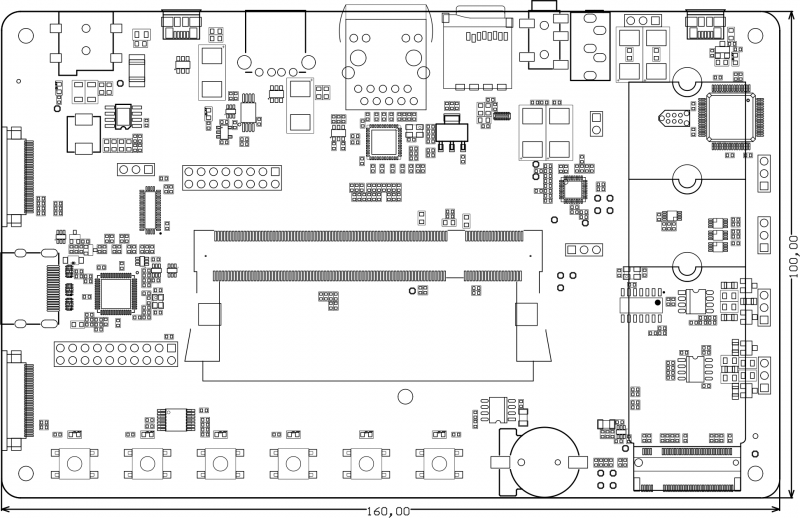VisionCB-8M-ADV Datasheet and Pinout: Difference between revisions
From SomLabs Wiki
| Line 315: | Line 315: | ||
<br>2. For configuration purposes is used I2C2 interface. | <br>2. For configuration purposes is used I2C2 interface. | ||
<br>3. MIPI-DSI interface is muxed with J901 (DISP MUX) between J900 (raw MIPI-DSI output) and HDMI/LVDS converter. | <br>3. MIPI-DSI interface is muxed with J901 (DISP MUX) between J900 (raw MIPI-DSI output) and HDMI/LVDS converter. | ||
<br>1. The I2C2 interface is common to onboard RTC, HDMI-DDC, LT8912B bridge configuration and MIPI-DSI display controller. | |||
== HDMI and LVDS display interface == | == HDMI and LVDS display interface == | ||
Revision as of 12:23, 1 February 2021

VisionCB-8M-ADV v.1.1 Datasheet and Pinout
General description
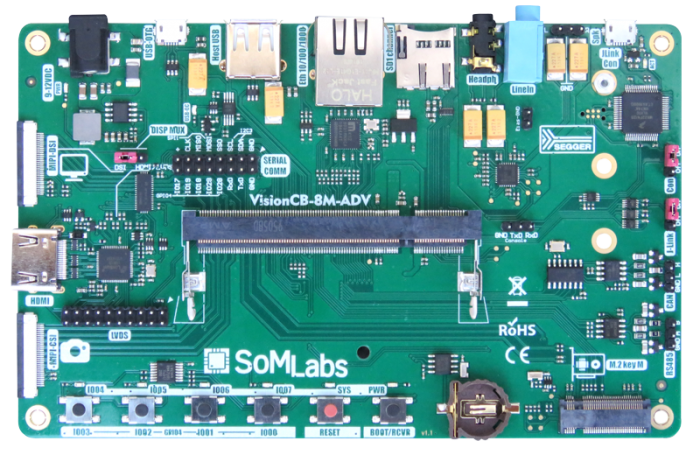
VisionCB-8M-ADV is a carrier board for the VisionSOM-8Mmini family of computer-on-modules which are powered by NXP SOC iMX8Mmini (quad core ARM Cortex-A53+ single Cortex-M4). A carrier board, together with a System on Module (SoM), makes a complete development platform similar to SBC. The carrier board houses the most common interfaces such as USB, Ethernet, PCIe, etc. A large variety of interfaces allows to use it as both a complete development platform or as a stand-alone end-product. The carrier board connects with the SoM via a standard SODIMM connector. VisionCB-8M-ADV carrier board is equipped with HDMI/LVDS and MIPI-DSI video outputs, 24-bit audio codec, PCIe (M.2 key M) socket (2242, 2260, 2280), on-board RTC with battery socket, RS-485 and CAN FD interfaces. VisionCB-8M-ADV carrier board is equipped with Segger J-Link debugger and Linux serial console port on USB vCOM.
Applications
- Multimedia
- Video streaming
- Industrial embedded Linux computer
- Home Appliances
- Home Automation – Smart Home
- Human-machine Interfaces (HMI)
- Point-of-sales (POS) terminals
- Cash Register
- 2D barcode scanners and printers
- IoT gateways
- Residential getaways
- Machine vision equipment
- Robotics
- Fitness/outdoor equipment
Features
- Carrier Board (Base Board) compatible with the VisionSOM-8Mini family of modules based on quad core, heterogenous NXP iMX8Mmini application processors
- SoM Interface: SODIMM200
- Debug Interface: built-in Segger J-Link JTAG debugger
- Expansion Connectors:
- Serial communication/GPIO connector 2x8 Pin Header (Male)
- MicroSD card socket
- Communication Connectors:
- PCIe (single lane, M.2 key M socket)
- RS-485 (simplex, 3 pin 2.54mm connector)
- CAN FD (3 pin 2.54mm connector)
- 1x Ethernet 10/100/1000Mbit/s, RJ45
- 1x USB Host Type A connectors
- 1x USB OTG Micro AB connector
- 1x Console MicroUSB B connector
- Display Interface:
- HDMI (muxed with MIPI-DSI)
- LVDS (20 pin 2.54 mm, muxed with MIPI-DSI)
- 30-pin FFC/FPC MIPI-DSI (up to 4 lanes)
- Camera Interface:
- 30-pin FFC/FPC MIPI-CSI2 (up to 4 lanes)
- User Interface:
- 24-bit audio codec
- Line and microphone inputs
- Speaker and headphone outputs
- 4+2 Pushbuttons
- 4+2+3 LEDs
- Built-in RTC with battery socket
- External Power Supply 9-12V DC
- Temperature Range: 0 to +70°C
- Board Size: 160mm x 100mm x 18mm
Pictures of VisionCB-8M-ADV v1.1 board
| Version | Photo |
|---|---|
| VisionCB-8M-ADV v1.1 board only |
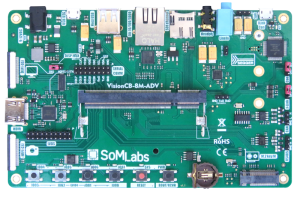 |
| VisionCB-8M-ADV v1.1 with VisionSOM-8Mmini |
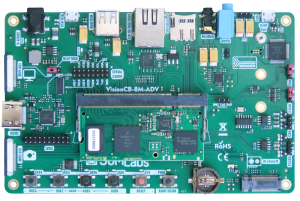 |
| VisionCB-8M-ADV v1.1 with VisionSOM-8Mmini and M.2 SSD drive |
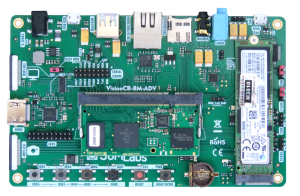 |
Ordering info
Block Diagram
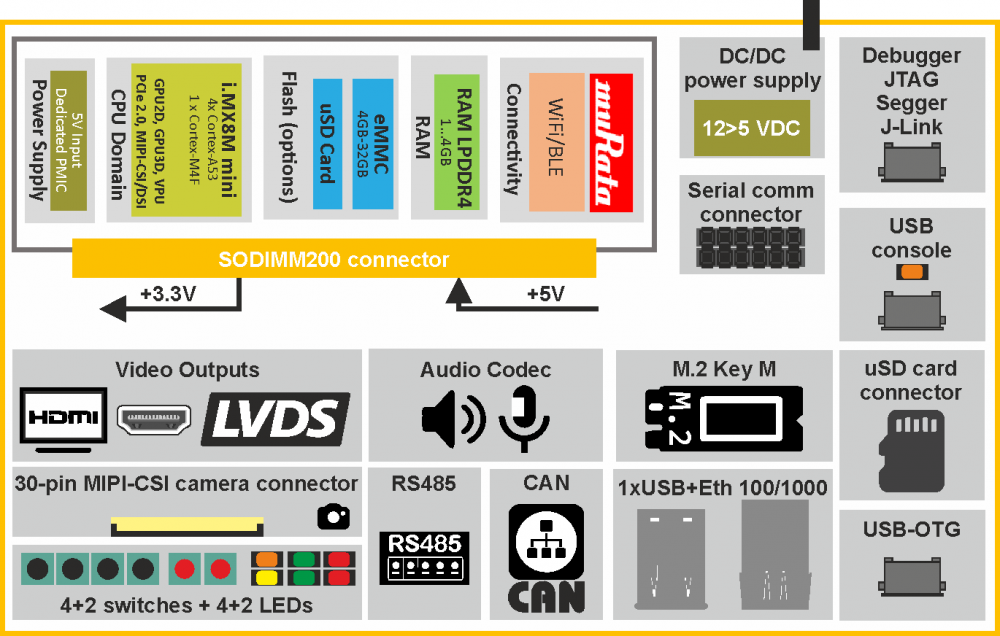
Electrical parameters
| Parameter | Value | Units | Comment | ||
|---|---|---|---|---|---|
| Min. | Typ. | Max. | |||
| Power Supply | 9.0 | 12.0 | 15.0 | V | Positive pole on central connector of J400 |
| Supply current | - | - | 0.65 | A | Excluding LCD, USB and antoher external loads |
| LCD/Camera Power Supply (logic) | 3.25 | 3.3 | 3.35 | V | - |
| LCD/Camera Power Supply (backlight and aux) | 4.85 | 5 | 5.1 | V | - |
| Arudino GPIO voltage | 3.3/5 | V | Selected by V-ARD jumper | ||
M.2 socket - key M (PCIe interface, J100)
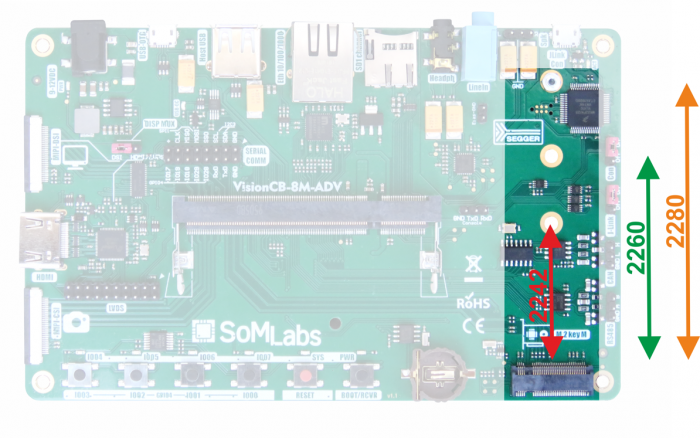
| MPU GPIO line | MPU GPIO group | M.2 line |
|---|---|---|
| IO11 | GPIO4 | PEWAKE# |
| IO12 | GPIO4 | CLKREQ# |
| IO13 | GPIO4 | PERST# |
| IO14 | GPIO4 | DEVSLP |
Note:
1. IO[14..11] are used optionally.
2. PCIe is single lane interface.
3. M.2 socket is key M type.
4. By default CONFIG[3..0]=1111b.
Camera MIPI-CSI interface (J301, FPC/FFC 0.5mm)
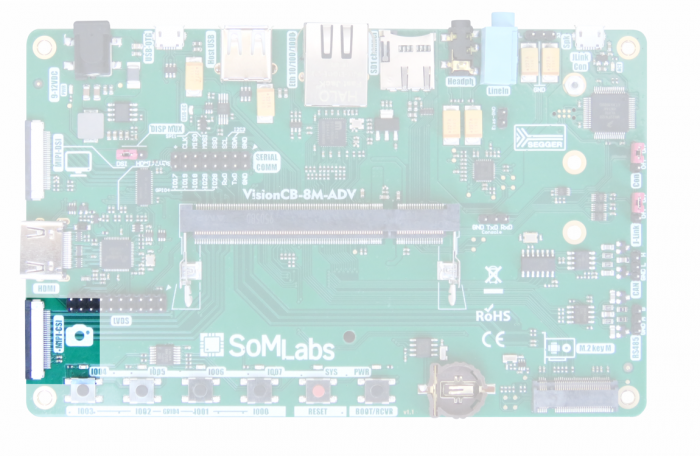
| Pin | Signal | MPU pin | Description |
|---|---|---|---|
| 1 | GND | - | - |
| 2 | CSI-CLK-P | - | - |
| 3 | CSI-CLK-P | - | - |
| 4 | GND | - | - |
| 5 | CSI-DATA0-P | - | - |
| 6 | CSI-DATA0-N | - | - |
| 7 | GND | - | - |
| 8 | CSI-DATA1-P | - | - |
| 9 | CSI-DATA1-N | - | - |
| 10 | GND | - | - |
| 11 | CSI-DATA2-P | - | - |
| 12 | CSI-DATA2-N | - | - |
| 13 | GND | - | |
| 14 | CSI-DATA3-P | - | - |
| 15 | CSI-DATA3-N | - | - |
| 16 | GND | - | - |
| 17 | I2C1-SCL | E9 | Camera confguration I2C interface with 4.7kOhm pull-up (3.3V) |
| 18 | I2C1-SDA | F9 | Camera confguration I2C interface with 4.7kOhm pull-up (3.3V) |
| 19 | GND | - | - |
| 20 | RES | AG19 | GPIO4-IO08 (SAI1-RXD6) |
| 21 | PWRDN | AF19 | GPIO4-IO09 (SAI1-RXD7) |
| 22 | - | - | - |
| 23 | GND | - | - |
| 24 | +3.3V | - | Power supply for external devices |
| 25 | +3.3V | - | Power supply for external devices |
| 26 | +5V | - | Power supply for external devices |
| 27 | +5V | - | Power supply for external devices |
| 28 | - | - | - |
| 29 | - | - | - |
| 30 | GND | - | - |
Note:
1. 1st pin of J301 connector is at the top of the image.
Display MIPI-DSI interface (J900, FPC/FFC 0.5mm)
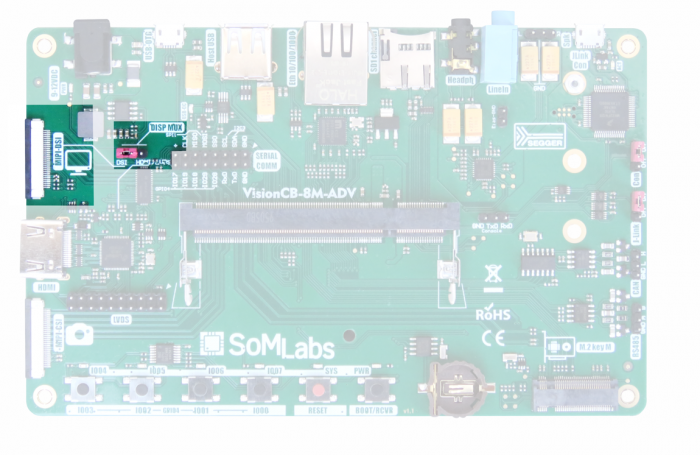
| Pin | Signal | MPU Pin | Description |
|---|---|---|---|
| 1 | GND | - | - |
| 2 | DSI-CLK-P | - | - |
| 3 | DSI-CLK-P | - | - |
| 4 | GND | - | - |
| 5 | DSI-DATA0-P | - | - |
| 6 | DSI-DATA0-N | - | - |
| 7 | GND | - | - |
| 8 | DSI-DATA1-P | - | - |
| 9 | DSI-DATA1-N | - | - |
| 10 | GND | - | - |
| 11 | DSI-DATA2-P | - | - |
| 12 | DSI-DATA2-N | - | - |
| 13 | GND | - | |
| 14 | DSI-DATA3-P | - | - |
| 15 | DSI-DATA3-N | - | - |
| 16 | GND | - | - |
| 17 | I2C2-SCL | D10 | Display confguration I2C interface with 4.7kOhm pull-up (3.3V) |
| 18 | I2C2-SDA | D9 | Display confguration I2C interface with 4.7kOhm pull-up (3.3V) |
| 19 | GND | - | - |
| 20 | GPIO5-IO22 | E14 | MIPI-DSI display reset signal (common with MIPI-DSI>HDMI/LVDS bridge) |
| 21 | GPIO5-IO23 | F13 | Optional touch-panel interrupt signal muxed with MIPI-DSI>HDMI/LVDS bridge (with 47k pull-up) |
| 22 | SPDIF-TX | AF9 | Optional touch-panel controller reset |
| 23 | GND | - | - |
| 24 | +3.3V | - | Power supply for external devices |
| 25 | +3.3V | - | Power supply for external devices |
| 26 | +5V | - | Power supply for external devices |
| 27 | +5V | - | Power supply for external devices |
| 28 | SPDIF-RX | AG9 | Optional backlight intensity PWM controller |
| 29 | SPDIF-CLK | AF8 | Optional backlight enable |
| 30 | GND | - | - |
Note:
1. 1st pin of J900 connector is at the top of the image.
2. For configuration purposes is used I2C2 interface.
3. MIPI-DSI interface is muxed with J901 (DISP MUX) between J900 (raw MIPI-DSI output) and HDMI/LVDS converter.
1. The I2C2 interface is common to onboard RTC, HDMI-DDC, LT8912B bridge configuration and MIPI-DSI display controller.
HDMI and LVDS display interface
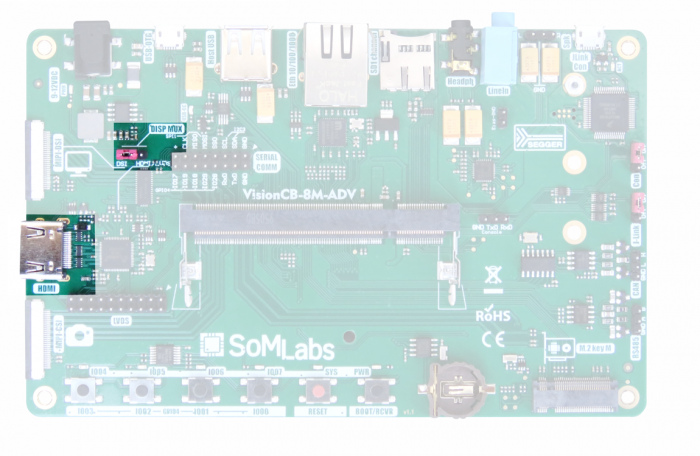
The VisionCB-8M-ADV board is equipped with MIPI-DSI > HDMI/LVDS hardware bridge (converter) based on Lontium LT8912B.
HDMI signals are available on standard HDMI connector (marked as HDMI), LVDS signals are connected to 20 pin 2.54mm 2 row connector (marked as LVDS).
The VisionCB-8M-ADV board is equipped with jumper (DISP MUX) for selecting displays: MIPI-DSI or HDMI/LVDS.
| Signal | MPU Pin | Description |
|---|---|---|
| DSI-CLK-P | - | Signal provided to LT8912B by mux (DISP MUX, J901) |
| DSI-CLK-P | - | Signal provided to LT8912B by mux (DISP MUX, J901) |
| DSI-DATA0-P | - | Signal provided to LT8912B by mux (DISP MUX, J901) |
| DSI-DATA0-N | - | Signal provided to LT8912B by mux (DISP MUX, J901) |
| DSI-DATA1-P | - | Signal provided to LT8912B by mux (DISP MUX, J901) |
| DSI-DATA1-N | - | Signal provided to LT8912B by mux (DISP MUX, J901) |
| DSI-DATA2-P | - | Signal provided to LT8912B by mux (DISP MUX, J901) |
| DSI-DATA2-N | - | Signal provided to LT8912B by mux (DISP MUX, J901) |
| DSI-DATA3-P | - | Signal provided to LT8912B by mux (DISP MUX, J901) |
| DSI-DATA3-N | - | Signal provided to LT8912B by mux (DISP MUX, J901) |
| HDMI-DETECT | AB19 | GPIO4-IO10 (SAI1_MCLK) |
| HDMI-INT | F13 | GPIO5-IO23, signal connected to LT8912B by mux (DISP MUX, J901) |
| HDMI-RES | E14 | GPIO5-IO22 (common with MIPI-DSI reset line) |
| I2C2-SCL | D10 | Display confguration I2C interface with 4.7kOhm pull-up (3.3V) |
| I2C2-SDA | D9 | Display confguration I2C interface with 4.7kOhm pull-up (3.3V) |
| SPDIF-TX | AF9 | Audio output, signal provided to LT8912B by mux (DISP MUX, J901) |
Note:
1. The I2C2 interface is common to onboard RTC, HDMI-DDC, LT8912B bridge configuration and MIPI-DSI display controller.
2. MIPI-DSI interface is muxed with J901 (DISP MUX) between J900 (raw MIPI-DSI output) and HDMI/LVDS converter.
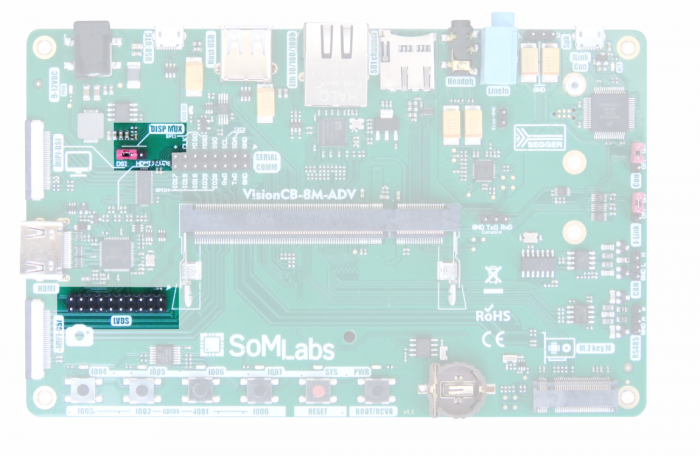
| J902 Pin | Signal | MPU pin |
|---|---|---|
| 1 | +5V power supply for external devices | - |
| 2 | +5V power supply for external devices | - |
| 3 | GPIO4-IO28 | AG8 (SAI3-RXFS, optional use) |
| 4 | GPIO4-IO29 | AG7 (UART2-CTS, optional use) |
| 5 | GND | - |
| 6 | GND | - |
| 7 | D0n | - |
| 8 | D0p | - |
| 9 | D1n | - |
| 10 | D1p | - |
| 11 | D2n | - |
| 12 | D2p | - |
| 13 | GND | - |
| 14 | GND | - |
| 15 | CLKn | - |
| 16 | CLKp | - |
| 17 | D3n | - |
| 18 | D3p | - |
| 19 | I2C2-SCL, confguration I2C interface with 4.7kOhm pull-up (3.3V) | D10 |
| 20 | I2C2-SDA, confguration I2C interface with 4.7kOhm pull-up (3.3V) | D9 |
Note:
1. 1st pin of J902 connector (LVDS) is marked with arrow.
2. The I2C2 interface is common to onboard RTC, HDMI-DDC, LT8912B bridge configuration and MIPI-DSI display controller.
USB Console Port and Segger J-Link debugger
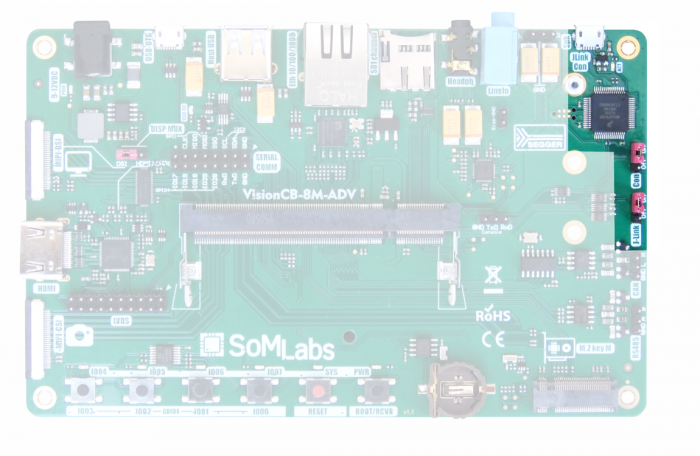
| MPU Port | GPIO | Description |
|---|---|---|
| CONSOLE-TXD | UART4-TXD | Signal connected to J304 pin 2 |
| CONSOLE-RXD | UART4-RXD | Signal connected to J304 pin 3 |
Notes:
1. Linux console port (UART4 in MPU) uses vCOM interface provided by built-in debugger Segger J-Link.
2. vCOM can be disconnected from MPU with JP801 (jumper CON in position ON or OFF).
3. Lines TXD and RXD of UART4 are easy to monitoring thanks to using J304 gold-pins.
4. Debug JTAG interface can be disconnected from MPU with JP801 (jumper J-LINK in position ON or OFF).
5. J-Link activity is monitored with ACT LED.
MicroSD card interface (J308)

| Card connector pin | SD card signal | SOM pin |
|---|---|---|
| 1 | DATA2 | SD1-DATA2 |
| 2 | DATA3 | SD1-DATA3 |
| 3 | CMD | SD1-CMD |
| 4 | NVCC-SDIO | Voltage selected 1.8/3.3V by SD1 driver |
| 5 | CLK | SD1-CLK |
| 6 | GND | - |
| 7 | DATA0 | SD1-DATA0 |
| 8 | DATA1 | SD1-DATA1 |
| 9 | CARD-DETECT | SD1-CD |
24-bit stereo audio codec
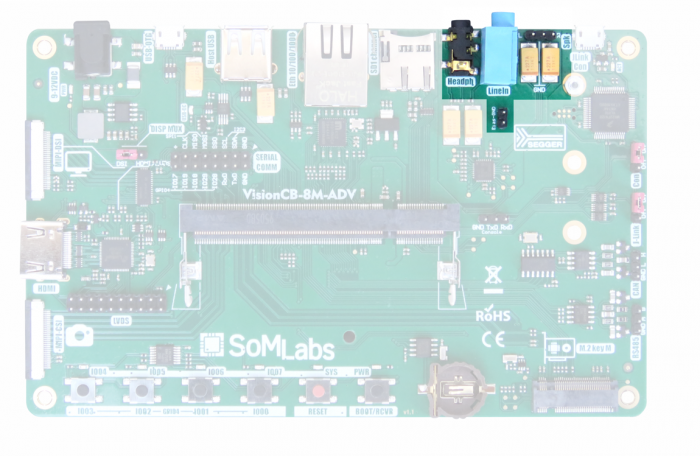
The VisionCB-8M-ADV board is equipped with 24-bit stereo codec - Nuvoton NAU88C22YG - with integrated audio amplifier.
| Signal | MPU pin | Description |
|---|---|---|
| SAI3-MCLK | AD6 | +3.3V generated by DC/DC built-in SOM (limited current load) |
| SAI3-TXC | AG6 | +5V generated by carrier board built-in DC/DC converter |
| SAI3-TXFS | AC6 | I2C1-SDA line |
| SAI3-TXD | AF6 | +5V generated by carrier board built-in DC/DC converter |
| SAI3-RXD | AF7 | I2C1-SDA line |
| I2C1-SCL | - | |
| I2C1-SDA | Universal GPIO with 3.3V logic levels |
Arduino Uno compatible I/O header
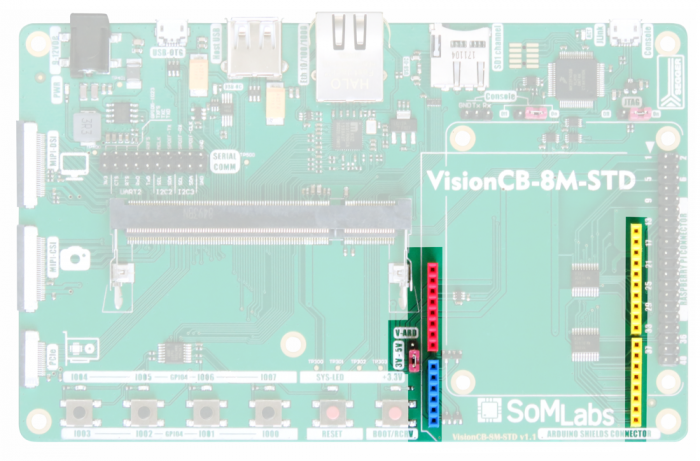
| Pin | Arduino name | Default function name | Description |
|---|---|---|---|
| Power connector J700, red connector | |||
| 1 | - | - | - |
| 2 | IOREF | VDD-ARDUINO-IO | Selected +3.3V or +5V (with V-ARD jumper). |
| 3 | RESET | POR-B | External reset input, active L. |
| 4 | 3.3V | VCC-3V3 | +3.3V generated by internal SOM LDO converter (limited load current). |
| 5 | 5V | VCC-5V0 | +5V generated by carrier board built-in DC/DC converter. |
| 6 | GND | GND | - |
| 7 | GND | GND | - |
| 8 | VIN | VCC-3V3 | +3.3V generated by internal SOM LDO converter (limited load current). |
| Analog inputs connector J702, blue connector | |||
| 1 | AIN0 | - | Not internally connected. |
| 2 | AIN1 | - | Not internally connected. |
| 3 | AIN2 | - | Not internally connected. |
| 4 | AIN3 | - | Not internally connected. |
| 5 | - | - | Not internally connected. |
| 6 | - | - | Not internally connected. |
| Digital I/Os connector J704, yellow connector | |||
| 1 | DIO0 | UART3-RXD | Default: UART3-RXD line or universal GPIO with 3.3/5V logic levels. |
| 2 | DIO1 | UART3-TXD | Default: UART3-TXD line or universal GPIO with 3.3/5V logic levels. |
| 3 | DIO2 | GPIO4-IO15 | Universal GPIO with 3.3/5V logic levels. |
| 4 | DIO3 | GPIO4-IO14 | Universal GPIO with 3.3/5V logic levels. |
| 5 | DIO4 | GPIO4-IO13 | Universal GPIO with 3.3/5V logic levels. |
| 6 | DIO5 | GPIO4-IO12 | Universal GPIO with 3.3/5V logic levels. |
| 7 | DIO6 | GPIO4-IO11 | Universal GPIO with 3.3/5V logic levels. |
| 8 | DIO7 | GPIO4-IO10 | Universal GPIO with 3.3/5V logic levels. |
| Digital I/Os connector J703, yellow connector | |||
| 1 | DIO8 | GPIO4-IO08 | Universal GPIO with 3.3/5V logic levels. |
| 2 | DIO9 | GPIO4-IO09 | Universal GPIO with 3.3/5V logic levels. |
| 3 | DIO10 | SPI1-SS0 | Default: SPI1-SS0 line or universal GPIO with 3.3/5V logic levels. |
| 4 | DIO11 | SPI1-MOSI | Default: SPI1-MOSI line or universal GPIO with 3.3/5V logic levels. |
| 5 | DIO12 | SPI1-MISO | Default: SPI1-MISO line or universal GPIO with 3.3/5V logic levels. |
| 6 | DIO13 | SPI1-CLK | Default: SPI1-CLK line or universal GPIO with 3.3/5V logic levels. |
| 7 | GND | GND | - |
| 8 | AREF | VDD-ARDUINO-IO | +3.3V or +5V selected with V-ARD jumper. |
| 9 | DIO14 | I2C1-SCL | Default: I2C1-SCL line or universal GPIO with 3.3/5V logic levels. |
| 10 | DIO15 | I2C1-SDA | Default: I2C1-SDA line or universal GPIO with 3.3/5V logic levels. |
Notes:
1. I/O logic levels are selected 3.3/5V with V-ARD jumper.
2. RESET line is 3.3 and 5V compatible.
Serial Communication/GPIO header (J305)
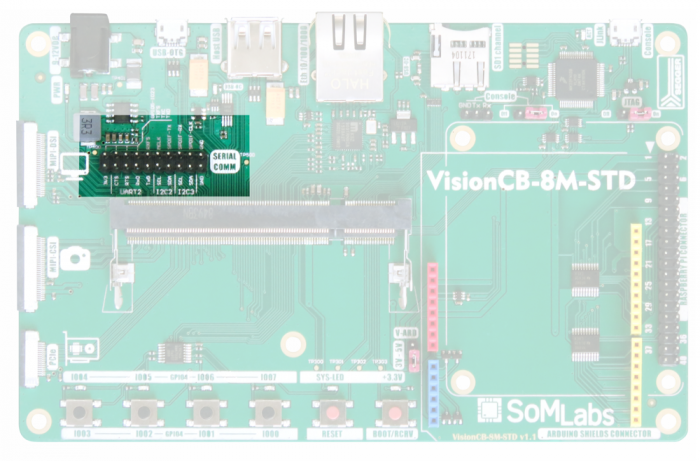
| Pin | Default function name | Description |
|---|---|---|
| 1 | +3.3V | +3.3V generated by DC/DC built-in SOM (limited current load) |
| 2 | GPIO5-IO23 | Universal GPIO with 3.3V logic levels By default is connected to MIPI-DSI (J301) as touch-panel interrupt line (with 47k pull-up) |
| 3 | UART2-CTS | By default: UART2-CTS or universal GPIO with 3.3V logic levels |
| 4 | SAI3-TXFS | By default: SAI3-TXFS or universal GPIO with 3.3V logic levels Connected to MIPI-CSI (J302) |
| 5 | UART2-RTS | By default: UART2-RTS or universal GPIO with 3.3V logic levels |
| 6 | SAI3-TXC | By default: SAI3-TXC or universal GPIO with 3.3V logic levels Connected to MIPI-CSI (J302) |
| 7 | UART2-RXD | By default: UART2-RXD or universal GPIO with 3.3V logic levels |
| 8 | SAI3-TXD | By default: SAI3-TXD or universal GPIO with 3.3V logic levels |
| 9 | UART2-TXD | By default: UART2-TXD or universal GPIO with 3.3V logic levels |
| 10 | SAI3-RXFS | By default: SAI3-RXFS or universal GPIO with 3.3V logic levels By default is connected to MIPI-DSI (J301) as display module reset signal |
| 11 | I2C2-SCL | By default: I2C2-SCL or universal GPIO with 3.3V logic levels Default I2C port for PCIe (J303), MIPI-DSI (J301) and MIPI-CSI (J302) |
| 12 | SAI3-MCLK | By default: SAI3-MCLK or universal GPIO with 3.3V logic levels |
| 13 | I2C2-SDA | By default: I2C2-SDA or universal GPIO with 3.3V logic levels Default I2C port for PCIe (J303), MIPI-DSI (J301) and MIPI-CSI (J302) |
| 14 | SPDIF-TX | By default: SPDIC-TX or universal GPIO with 3.3V logic levels By default is connected to MIPI-DSI (J301) as touch-panel reset signal |
| 15 | I2C3-SCL | By default: I2C3-SCL or universal GPIO with 3.3V logic levels |
| 16 | SPDIF-RX | By default: I2C3-SCL or universal GPIO with 3.3V logic levels By default is connected to MIPI-DSI (J301) as display module PWM backlight control |
| 17 | I2C3-SDA | By default: I2C3-SDA or universal GPIO with 3.3V logic levels |
| 18 | SPDIF-CLK | By default: SPDIF-CLK or universal GPIO with 3.3V logic levels By default is connected to MIPI-DSI (J301) as display module on/off signal |
| 19 | GND | - |
| 20 | GND | - |
User Interface (switches and LEDs)
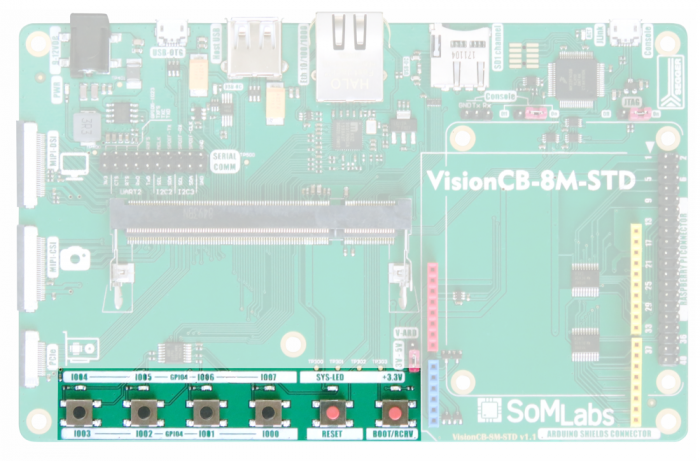
User switches
| Switch | GPIO | Description |
|---|---|---|
| S305 (black, most on the left) | GPIO4-IO03 | 47k pull-up |
| S304 | GPIO4-IO02 | 47k pull-up |
| S303 | GPIO4-IO01 | 47k pull-up |
| S302 (black, most on the right) | GPIO4-IO00 | 47k pull-up |
System switches
| Switch | Signal name | Description |
|---|---|---|
| S301 (left, red) | Reset | - |
| S300 (right, red) | BOOT-RECOVERY | - |
User LEDs
| LED | GPIO | Description |
|---|---|---|
| D303 (most on the left) | GPIO4-IO04 | User LED1, buffered with inverter |
| D302 | GPIO4-IO05 | User LED2, buffered with inverter |
| D301 | GPIO4-IO06 | User LED3, buffered with inverter |
| D300 (most on the right) | GPIO4-IO07 | User LED4, buffered with inverter |
System LEDs
| LED | GPIO | Description |
|---|---|---|
| D304 | SYS-LED | System function monitoring |
| D305 | - | Power LED (3.3V) |
Dimensions
